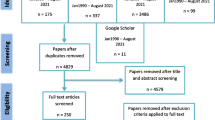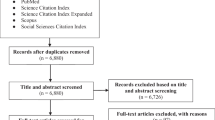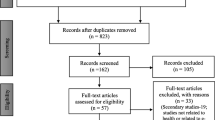Abstract
The aim of this study is to understand the phenomenon of e-learning in orthodontic graduate education. The study has assessed e-learning based on two objectives, with the primary objective, summarising the outcomes and implications of e-learning over other forms of learning. The outcomes have been further discussed under primary and secondary measures. The secondary objective was to understand the impediments in the integration of technological advances in orthodontic educational instruction. The study conducted a comprehensive electronic search in the English language from January 1980 up to April 2019 on PubMed, Medline, EMBASE and Google Scholar. The search incorporated standard Boolean operators and keywords. The Problem/Patient/Population, Intervention, Comparison or Control, and Outcome (PICO) criteria were applied in the selection of reviewed articles. Pre-set inclusion and exclusion criteria were followed for article selection. Following the above-mentioned parameters, a total of twenty-one studies met the inclusion criteria with seventeen studies measuring the primary outcome of knowledge and skill gain. Twelve studies assessing the secondary outcome comprised of students’ attitudes towards e-learning instructions. All the twenty-one studies provided an understanding on the methods employed and content delivered through computer assisted learning. Overall, knowledge gain and student’s attitudes were found to be positive following e-learning. However, more e-learning programs and learning environments with interactive experiences must be developed and tested to fully understand the effects these systems offer. The review, in addition, has highlighted the implications and impediments of technology-assisted learning with a proposed step-wise approach in overcoming these challenges. The review concludes with a brief introduction into a new concept of smart learning environment.

Similar content being viewed by others
References
Al-Jewair, T. S., Azarpazhooh, A., Suri, S., & Shah, P. S. (2009). Computer-assisted learning in orthodontic education: A systematic review and meta-analysis. Journal of Dental Education, 73(6), 730–739.
Alqahtani, N. D., Al-Jewair, T., AL-Moammar, K., Albarakati, S. F., & Alkofide, E. A. (2015). Live demonstration versus procedural video: A comparison of two methods for teaching an orthodontic laboratory procedure. BMC Medical Education, 15, 199. https://doi.org/10.1186/s12909-015-0479-y.
Aly, M., Willems, G., Carels, C., & Elen, J. (2003). Instructional multimedia programs for self-directed learning in undergraduate and postgraduate training in orthodontics. European Journal of Dental Education, 7, 20–26.
Aly, M., Elen, J., & Willems, G. (2004). Instructional multimedia program versus standard lecture: A comparison of two methods for teaching the undergraduate orthodontic curriculum. European Journal of Dental Education, 8, 43–46.
Andrews, K. G., & Demps, E. L. (2003). Distance education in the U.S. and Canadian undergraduate dental curriculum. Journal of Dental Education, 67(4), 427–438.
Bednar, E. D., Hannum, W. M., Firestone, A., Silveira, A. M., Cox, T. D., & Proffit, W. R. (2007). Application of distance learning to interactive seminar instruction in orthodontic residency programs. American Journal of Orthodontics and Dentofacial Orthopedics, 132, 586–594.
Behar-Horenstein, L. S., & Horvath, Z. (2016). Generational learning differences in Today’s dental students: A popular myth. Journal of Dental Education, 80(5), 588–594.
Berman, N. B., Fall, L. H., Maloney, C. G., & Levine, D. A. (2008). Computer-assisted instruction in clinical education: A roadmap to increasing CAI implementation. Advances in Health Sciences Education: Theory and Practice, 13(3), 373–383.
Bhola, S. (2017). E-learning as a platform for the future of education in dentistry. International Journal of Educational Policy Research and Review, 4(2), 14–18.
Blue, C., & Henson, H. (2015). Millennials and dental education: Utilizing educational Technology for Effective Teaching. American Dental Hygienists Association, 89(suppl 1), 46–47.
Buchanan, J. A. (2001). Use of simulation technology in dental education. Journal of Dental Education, 65(11), 1225–1231.
Chadwick, S. M., Bearn, D. R., Jack, A. C., & O’Brien, K. D. (2002). Orthodontic undergraduate education: Developments in a modern curriculum. European Journal of Dental Education, 6, 57–63.
Clark, R. D., Weerakone, S., & Rock, W. P. (1997). A hypertext tutorial for teaching cephalometrics. British Journal of Orthodontics, 24, 325–328.
Cohen, H. B., Walker, S. R., Tenenbaum, H. C., & Spero, L. (2003). Interdisciplinary, web-based, self-study, interactive programs in the dental undergraduate program: A pilot. Journal of Dental Education, 67(6), 661–667.
DiLullo, C., McGee, P., & Kriebel, R. M. (2011). Demystifying the millennial student: A reassessment in measures of character and engagement in professional education. Anatomical Sciences Education, 4, 214–226.
Evans, L., & Hanes, P. J. (2014). Online cultural competency education for millennial dental students. Journal of Dental Education, 78(6), 867–875.
Fletcher, R. H., Fletcher, S. W., & Wagner, E. H. (1996). Clinical epidemiology: The essentials. Baltimore: Williams and Wilkins.
Gadbury-Amyot, C. C., Overman, P. R., & Crain, G. (2009). The development and implementation of an online applied biochemistry bridge course for a dental hygiene curriculum. Journal of Dental Education, 73(1), 83–94.
Grimes, E. B. (2002). Student perceptions of an online dental terminology course. Journal of Dental Education, 66(1), 100–107.
Gros, B. (2016). The design of smart educational environments. Smart Learning Environments, 3(1). https://doi.org/10.1186/s40561-016-0039-x.
Haig, A., & Dozier, M. (2003). BEME guide no. 3: Systematic searching for evidence in medical education—Part 1: Sources of information. Medical Teacher, 25(4), 352–363.
Hammond, R. M., & Freer, T. J. (1997). Application of a case-based expert system to orthodontic diagnosis and treatment planning. Australasian Orthodontic Journal, 14, 229–234.
Haynes, R. B., Sackett, D. L., Richardson, W. S., Rosenberg, W., & Langley, G. R. (1997). Evidence-based medicine: How to practice & teach EBM. Canadian Medical Association Journal, 157(6), 788.
Hendricson, W. D. (2012). Changes in educational methodologies in predoctoral dental education: Finding the perfect intersection. Journal of Dental Education, 76(1), 118–141.
Hendricson, W. D., Panagakos, F., Eisenberg, E., McDonald, J., Guest, G., & Jones, P. (2004). Electronic curriculum implementation at north American dental schools. Journal of Dental Education, 68, 1041–1057.
Hendricson, W., Eisenberg, E., Guest, G., Jones, P., Johnson, L., & Panagakos, F. (2006). What do dental students think about mandatory laptop programs? Journal of Dental Education, 70(5), 480–499.
Hobson, R. S., Carter, N. E., Hall, F. M., & Atkins, M. J. (1998). A study into the effectiveness of a text-based computer-assisted learning program in comparison with seminar teaching of orthodontics. European Journal of Dental Education, 2, 154–159.
Honey, P., & Mumford, A. (1982). The manual of learning styles. Maidenhead: Peter Honey.
Hwang, G. J. (2014). Definition, framework and research issues of smart learning environments- a context aware ubiquitous learning perspective. Smart Learning Environments, 1(4), 1–14.
Ireland, A. J., Atack, N. E., & Sandy, J. R. (2012). Experiences of wiki topic teaching in postgraduate orthodontics: What do the learners think? European Journal of Dental Education, 17, e109–e113.
Irvine, N. R., & Moore, R. N. (1986). Computer-assisted instruction in mixed dentition analysis. Journal of Dental Education, 50(6), 312–315.
Jackson, T. H., Hannum, W. H., Koroluk, L., & Proffit, W. R. (2011). Effectiveness of web-based teaching modules: Test-enhanced learning in dental education. Journal of Dental Education, 75(6), 775–781.
Johnson, L., Becker, S. A., & Cummins, M. (2013). NMC horizon report: Higher education edition. Austin: New Media Consortium.
Kinzie, M. B. (1990). Requirements and benefits of effective interaction instruction: Learner control, self-regulation, and continuing motivation. Educational Technology Research and Development, 38, 5–21.
Klein, K. P., Hannum, W. H., Fields, H. W., & Proffit, W. R. (2012). Interactive distance learning in orthodontic residency programs: Problems and potential solutions. Journal of Dental Education, 76(3), 322–329.
Komolpis, R., & Johnson, R. A. (2002). Web-based orthodontic instruction and assessment. Journal of Dental Education, 66(5), 650–658.
Licari, F. W. (2007). Faculty development to support curriculum change and ensure the future vitality of dental education. Journal of Dental Education, 71(12), 1509–1512.
Linjawi, A. L., Hamdan, A. M., Perryer, D. G., Walmsley, A. D., & Hill, K. B. (2009). Students’ attitudes towards an on-line orthodontic learning resource. European Journal of Dental Education, 13, 87–92.
Lowe, C. I., Wright, J. L., & Bearn, D. R. (2001). Computer-aided Learning (CAL): An effective way to teach the Index of Orthodontic Treatment Need (IOTN)? Journal of Orthodontics, 28, 307–311.
Ludwig, B., Bister, D., Schott, T. C., Lisson, J. A., & Hourfar, J. (2016). Assessment of two e-learning methods teaching undergraduate students cephalometry in orthodontics. European Journal of Dental Education, 20, 20–25.
Luffingham, J. K. (1984). An assessment of computer-assisted learning in orthodontics. British Journal of Orthodontics, 11(4), 205–208.
Malaysia Education Blueprint 2015-2025 (Higher Education). Retrieved 27 April 2019 from http://www.mohe.gov.my/muat-turun/awam/penerbitan/pppm-2015-2025-pt/6-executive-summary-pppm-2015-2025.
Marsh, C. M., Hannum, W. H., Trotman, C. A., & Proffit, W. R. (2001). Design and effectiveness of a computer-based continuing education program for orthodontists. Angle Orthodontist, 71, 71–75.
McCann, A. L., Schneiderman, E. D., & Hinton, R. J. (2010). E-teaching and learning preferences of dental and dental hygiene students. Journal of Dental Education, 74(1), 65–78.
Mehta, S., Clarke, F., & Fleming, P. S. (2016). An assessment of student experiences and learning based on a novel undergraduate e-learning resource. British Dental Journal, 221(3), 131–136.
Moher, D., Liberati, A., Tetzlaff, J., & Altman, D. G. (2009). The PRISMA group. Preferred reporting items for systematic reviews and meta-analyses: The PRISMA statement. PLoS Medicine, 6(7), e1000097.
Naser-ud-Din, S. (2015). Introducing scenario based learning interactive to postgraduates in UQ orthodontic program. European Journal of Dental Education, 19, 169–176.
Reynolds, P. A., Mason, R., & Eaton, K. A. (2008). Remember the days in the old school yard: From lectures to online learning. British Dental Journal, 204(8), 447–451.
Rosenberg, H. (2008). An evaluation of computer-aided learning in orthodontics, master’s thesis. Toronto: Faculty of Dentistry, University of Toronto.
Rosenberg, H., Sander, M., & Posluns, J. (2005). The effectiveness of computer-aided learning in teaching orthodontics: A review of the literature. American Journal of Orthodontics and Dentofacial Orthopedics, 127(5), 599–605.
Rosenberg, H., Posluns, J., Tenenbaum, H. C., Tompson, B., & Locker, D. (2010). Evaluation of computer-aided learning in orthodontics. American Journal of Orthodontics and Dentofacial Orthopedics, 138(4), 410–419.
Ruiz, J. G., Mintzer, M. J., & Leipzig, R. M. (2006). The impact of e-learning in medical education. Academic Medicine, 81, 207–212.
Schardt, C., Adams, M. B., Owens, T., Keitz, S., & Fontelo, P. (2007). Utilization of the PICO framework to improve searching PubMed for clinical questions. BMC Medical Informatics and Decision Making, 7, 16.
Schönwetter, D. J. (2016). Assessing the impact of voice-over screen captured presentations delivered online on dental students’ learning. Journal of Dental Education, 80(2), 141–148.
Schönwetter, D. J., Reynolds, P. A., & Eaton, K. A. (2010). Online learning in dentistry: An overview of the future direction for dental education. Journal of Oral Rehabilitation, 37(12), 927–940.
Schorn-Borgmann, S., Lippold, C., Wiechmann, D., & Stamm, T. (2015). The effect of e-learning on the quality of orthodontic appliances. Advances in Medical Education and Practice, 6, 545–552.
Spector, J. M. (2014). Conceptualizing the emerging field of smart learning environments. Smart Learning Environments, 1(2), 1–10.
Spiro, R. J., Feltovich, P. J., Jacobson, M. J., & Coulson, R. L. (1991). Knowledge representation, content specification, and the development of skill in situation-specific knowledge assembly. Educational Technology, 31, 22–25.
The University of Sydney School of Dentistry Overarching Strategic Goals and Objectives 2018-22. Retrieved 27 April 2019 from https://sydney.edu.au/content/dam/corporate/documents/faculty-of-medicine-and-health/dentistry/sydney-dental-school-strategic-plan.pdf.
Turner, P. J., & Weerakone, S. (1992). Computer-based learning in orthodontics - a hypertext system. British Journal of Orthodontics, 173, 317–319.
Turner, P. J., & Weerakone, S. (1993). An evaluation of a hypertext system for computer-assisted learning in orthodontics. British Journal of Orthodontics, 20, 145–148.
UK College of Dentistry Strategic Plan 2016-2020. Retrieved 27 April 2019 from https://dentistry.uky.edu/sites/default/files/UKCDStrategicPlan2016.pdf.
Ulkur, F., Germec-Cakan, D., & Ozdemir, F. (2015). Comparison of outcomes of recorded lecture and hands-on course education in orthodontic cast analysis. Turkish Journal of Orthodontics, 28(1), 13–18.
University of Florida College of Dentistry, Strategic Plan 2019-2024. Retrieved 27 April 2019 fromhttps://cod-strategic-plan.sites.medinfo.ufl.edu/files/2018/07/18-UFCD-Strategic-Plan-FINAL.pdf.
University of Iowa College of Dentistry Strategic Plan 2015-2020. Retrieved 27 April 2019 from https://www.dentistry.uiowa.edu/sites/default/files/docs/admin/COD_Strategic_Plan_2015-20.pdf.
University of Louisville School of Dentistry (ULSD), Strategic Plan, 2017-2020. Retrieved 27 April 2019 from http://louisville.edu/dentistry/about/strategic-plan-2017-2020.
University of Toronto, Achieving Impact through Excellence, Strategic Plan, 2014-2019. Retrieved 27 April 2019 from https://www.dentistry.utoronto.ca/sites/default/files/2016-06/strategic_plan_2014-2019.pdf.
Uskov, V., Bakken, J. P., Heinemann, C., Rachakonda, R., Guduru, V. S., Thomas, A. B., & Bodduluri, D. P. (2017). Building smart learning analytics system for Smart University. London: Springer International Publishing.
Waxman, H. C., Fen, L. M., & Michko, G. M. (2003). A meta-analysis of the effectiveness of teaching and learning with technology on student outcomes. Chicago: Learning Point Associates, sponsored under government contract number ED-01-CO-0011.
Welbury, R. R., Hobson, R. S., Stephenson, J. J., & Jepson, N. J. (2001). Evaluation of a computer-assisted learning programme on the orofacial signs of child physical abuse (non-accidental injury) by general dental practitioners. British Dental Journal, 190(12), 668–670.
Williams, M. D. (1996). Learner-control and instructional technologies. In D. H. Jonassen (Ed.), Handbook of research for educational communications and technology (pp. 957–982). London: Macmillan.
Acknowledgements
The authors of this study did not receive an aid or advice from other persons.
Funding
The study was supported by Bridging Grant from Universiti Sains Malaysia. Project no: 304.CIPPT.6316053.
Author information
Authors and Affiliations
Contributions
(I) Conception and design: All authors; (II) Administrative support: Mokhtar N; (III) Provision of study material: All authors; (IV) Collection and assembly of data: Authors 1 and 2; (V) Data analysis and interpretation: Authors 1; (VI) Manuscript writing: All authors; (VII) Final approval of manuscript: All authors.
Corresponding author
Ethics declarations
Competing interests
The authors declare that they have no competing interests of any kind.
Ethics approval
This manuscript is a review article and hence no ethical approval was required. This manuscript does not contain any research findings done on humans or animals.
Additional information
Publisher’s note
Springer Nature remains neutral with regard to jurisdictional claims in published maps and institutional affiliations.
Rights and permissions
About this article
Cite this article
Rao, G.K.L., Iskandar, Y.H.P. & Mokhtar, N. Understanding the nuances of E-learning in orthodontic education. Educ Inf Technol 25, 307–328 (2020). https://doi.org/10.1007/s10639-019-09976-2
Received:
Accepted:
Published:
Issue Date:
DOI: https://doi.org/10.1007/s10639-019-09976-2




